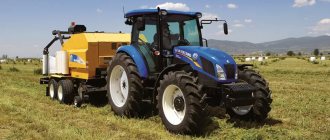When an organization owns and manages one or more company vehicles on its balance sheet, it is constantly faced with the task of purchasing fuel, justifying its use, and writing it off as expenses.
Current tax rules allow you to reduce the income tax base due to this write-off, but only if they are correctly justified in the relevant reporting documentation.
Therefore, it is extremely important to correctly keep records of spent fuels and lubricants and comply with the write-off standards established by the Ministry of Transport of the Russian Federation.
Let's consider what standards for fuels and lubricants are relevant today, how they depend on the season, as well as the nuances that may arise when justifying their write-off in ambiguous cases. We will show with an example how to correctly calculate the standard calculation of write-off of fuel and lubricants.
How to recognize expenses for fuel and lubricants for tax purposes ?
How are regulations regulated?
A vehicle requires fuel to operate. Each category of car requires different volumes of fuel and lubricants. The Ministry of Transport has developed a special standard - this is the fuel consumption rate for car brands. The standard allows you to determine how much fuel and lubricants a specific brand of vehicle requires to support the technological process. The standards are developed only in relation to the operating process of vehicles. For example, it is unacceptable to use values to calculate the write-off of fuel and lubricants during repair, adjustment or testing. For technological purposes, additional fuel consumption standards (FLC) should be established.
The Ministry of Transport introduced the standards by a separate Order No. AM-23-r dated March 14, 2008 (as amended on September 20, 2018). The document establishes several categories of standards for fuel and fuel consumption:
- Basic standard for gasoline consumption in liters per 100 km in running order.
- Transport standard in liters per 100 km in operation (during transport work), including:
- cost standard for a bus taking into account curb weight and nominal passenger load;
- consumption standard for dump trucks, taking into account equipment and nominal vehicle load.
- Transport standard for a truck in liters per 100 ton-kilometers, determined during transport work.
Standards are set in liters, for example, for gasoline or diesel fuel. Or the standards are fixed in cubic meters if, for example, transport consumes gas.
What determines the value of the fuel and lubricants indicator?
Recommended by the Ministry of Transport of the Russian Federation or independently developed by the enterprise, fuel write-off standards depend on objective factors:
- type of transport (passenger car, truck, truck, special purpose vehicle, etc.);
- specific car brand;
- its mileage;
- the period during which the car is in operation;
- basic fuel consumption;
- some established coefficients - seasonal, territorial, road, load-lifting, etc.
Is it possible to develop individual standards?
Whether or not to use the standards of the Ministry of Transport in your work is the decision of the company’s management. That is, at the legislative level there are no requirements for the mandatory use of NRT.
The Tax Code does not require standardization of costs for fuels and lubricants either according to the corporate income tax or under the simplified tax system. A similar position is supported by the Ministry of Finance (Letters dated March 22, 2019 No. 03-03-07/19283, dated September 27, 2018 No. 03-11-11/69335). Each organization must make its own decision about working with fuel standards.
Cost standards are allowed to be developed independently. For example, an institution, based on the recommendation of the Ministry of Transport, approves its own standards. The indicators correspond to the real characteristics of vehicles used in the process of life.
The ministry's recommendations are just standard values calculated based on the general characteristics of car brands. Despite the correction factors, in practice the values differ significantly from the actual costs. Therefore, organizations have the right to approve their own indicators.
Approve standard values by local order.
How to count
Officials identified three main concepts:
| Basic NRT | This is the standard cost of fuel and lubricants. Installed separately for each brand of vehicle. Takes into account individual designs, curb weight, type of fuel consumed and other characteristics. The type of flow is applicable for standard, typified situations. |
| Transport NZT | This type of regulatory use is applied taking into account the characteristics of the transport operation of the unit. In essence, this is a basic standard, recalculated taking into account the carrying capacity, towing force, and the rated load of cargo or passengers. That is, a standard taking into account the performance characteristics of the car. |
| Operational NRT | This is a real cost standard, which is recalculated taking into account correction factors. These are basic and transport NRT, which take into account the operating conditions of the vehicle (terrain, climate, temperature conditions and other operating features). |
Each of the standard values is recalculated in relation to the base value, taking into account correction factors. A detailed table of fuel consumption standards for 2022 reveals values by car brand. Abbreviations in the table:
- B - gasoline;
- D - diesel fuel;
- LPG - liquefied petroleum gas;
- CNG is compressed natural gas.
| Model, brand, modification of the car | Basic rate, l/100 km | Type of fuel |
| VAZ-1111 "Oka" | 6,5 | B |
| VAZ-11113 "Oka" (VAZ-11113-2L-0.75-35-4M) | 5,6 | B |
| VAZ-11183 "Kalina" (VAZ-21114-4L-1,596-81-5M) | 8,0 | B |
| VAZ-2104 | 8,5 | B |
| VAZ-21041 (VAZ-21067.10-4L-1,568-74,5-5M) | 9,1 | B |
| VAZ-21043 (VAZ-2103-4L-1.45-71-5M) | 8,3 | B |
| VAZ-21043 (VAZ-2103-4L-1,451-71,5-4M) | 9,0 | B |
| VAZ-2105, -21051, -21053 | 8,5 | B |
| VAZ-2106 (VAZ-2106-4L-1.57-75.5-5M) | 8,5 | B |
| VAZ-2106 (VAZ-2106-4L-1.57-75.5-4M) | 9,0 | B |
| VAZ-21061 | 9,0 | B |
| VAZ-21063 (VAZ-2130-4L-1.77-82-5M) | 9,0 | B |
| VAZ-2107 (VAZ-2103-4L-1.45-72.5-4M) | 8,6 | B |
| VAZ-21072 (VAZ-2105-4L-1.3-63.5-4M) | 8,9 | B |
| VAZ-21074 (VAZ-2106-4L-1.57-75.5-5M) | 8,5 | B |
| VAZ-21074 (VAZ-21067-4L-1,568-74,5-5M) | 8,9 | B |
| VAZ-2108, -2108 “Sputnik”, -21081, -21083, -2109 | 8,0 | B |
| VAZ-21093 (VAZ-2111-4L-1,499-79-5M) | 7,7 | B |
| VAZ-21093; -21099 1.5i (VAZ-21083-20-4L-1.5-71-5M) | 7,5 | B |
| VAZ-21099 (VAZ-2111-4L-1,499-79-5M) | 7,8 | B |
| VAZ-2110 1.5i (VAZ-21083-20-4L-1.5-71-5M) | 7,4 | B |
| VAZ-2110-010 (VAZ-2110-4L-1,499-73-5M) | 7,8 | B |
| VAZ-21102 (VAZ-2111-4L-1,499-79-5M) | 7,5 | B |
| VAZ-21103 (VAZ-2112-4L-1,499-92-5M) | 7,7 | B |
| VAZ-21104 (VAZ-21124-4L-1,596-90-5M) | 8,4 | B |
| VAZ-2111 (VAZ-2111-4L-1,499-79-5M) | 7,6 | B |
| VAZ-21112-00 1.6 (VAZ-21114-4L-1,596-80-5M) | 8,3 | B |
| VAZ-21113 (VAZ-2112-4L-1,499-92-5M) | 7,8 | B |
| VAZ-2112 (VAZ-2112-4L-1,499-92-5M) | 7,7 | B |
| VAZ-21140 (VAZ-2111-4L-1,499-79-5M) | 7,9 | B |
| VAZ-21150 (VAZ-2111-4L-1,499-79-3,94-5M) | 7,4 | B |
| VAZ-2120 (VAZ-2130-4L-1,774-82-5M) | 10,7 | B |
| VAZ-212090 "Bronto" armor. (VAZ-2130-4L-1,774-82-5M) | 12,5 | B |
| VAZ-2121, -21211 | 12,0 | B |
| VAZ-21213 (VAZ-21213-4L-1,690-80-5M) | 11,5 | B |
| VAZ-21213B armor. (VAZ-21213-4L-1.69-79-5M) | 12,1 | B |
| VAZ-21214-20 “Chevrolet Niva” (VAZ-21214.10-4L-1,689-82-5M) | 10,9 | B |
| VAZ-21218 (VAZ-21213-4L-1.69-79-5M) | 11,9 | B |
| VAZ-212182 armored (VAZ-21213-4L-1.69-79-5M) | 12,3 | B |
| VAZ-212300 "Chevrolet Niva" (VAZ-2123-4L-1.69-80-5M) | 10,5 | B |
| VAZ-2131 (VAZ-21213-4L-1.69-80-5M) | 11,3 | B |
| VAZ-21310 (VAZ-2130-4L-1,774-82-5M) | 11,5 | B |
| VAZ-213102 "Bronto" armor. (VAZ-2130-4L-1,774-80-5M) | 12,4 | B |
| VAZ-21312 (VAZ-2130-4L-1,774-82-5M) | 11,4 | B |
| VAZ-2302 “Bison” (VAZ-2121-4L-1.57-78-4M) | 11,5 | B |
| GAZ-13 | 20,0 | B |
| GAZ-14 | 22,0 | B |
| GAZ-24, -24-10, -24-60 | 13,0 | B |
| GAZ-24-01, -24-03, -24-11, -24-14, -24T | 13,5 | B |
| GAZ-24-02, -24-04 | 14,0 | B |
| GAZ-24-07 | 16,5 | CIS |
| GAZ-24-12, -24-13 (with engine ZMZ-402, -402.10) | 13,5 | B |
| GAZ-24-12, -24-13 (with engine ZMZ-4021, -4021.10) | 14,0 | B |
| GAZ-24-17, -24-25 | 16,5 | CIS |
| GAZ-3102 (with engine ZMZ-4022.10) | 13,0 | B |
| GAZ-3102 (Chrysler-4L-2,429-137-5M) | 10,7 | B |
| GAZ-3102 (Toyota 3RZ-FE-4L-2,694-152-5M) | 11,2 | B |
| GAZ-3102, -3102-12 (ZMZ-4062.10-4L-2.3-150-4M) | 12,5 | B |
| GAZ-3102-12; GAZ-3102 (ZMZ-4062.10-4L-2.3-150-5M) | 12,0 | B |
| GAZ-310200 (Toyota-6V-3,378-194-4A) | 13,8 | B |
| GAZ-310200 (Rover-8V-3.95-182-5M) | 13,5 | B |
| GAZ-31022 (ZMZ-4021.10-4L-2,445-90-4M) | 13,9 | B |
| GAZ-310221 (ZMZ-40210D-4L-2,445-81-5M) | 13,1 | B |
| GAZ-310221 (ZMZ-40620D-4L-2.3-131-5M) | 11,5 | B |
| GAZ-31029 (Rover-4L-1,994-140-5M) | 11,5 | B |
| GAZ-31029 (ZMZ-402; 402.10 - 4L-2,445-100-4M) | 13,0 | B |
| GAZ-31029 (ZMZ-4021; 4021.10 - 4L-2,445-90-4M) | 13,5 | B |
| GAZ-3105 (8V-3.4-170-5M) | 13,7 | B |
| GAZ-3110 (ZMZ-4026.10; -40200F-4L-2,445-100-4M) | 13,0 | B |
| GAZ-3110 (Rover-4L-1,996-136-5M) | 10,7 | B |
| GAZ-3110 (ZMZ-4020 OM-4L-2,445-100-5M) | 12,2 | B |
| GAZ-3110 (ZMZ-4062.10-4L-2,287-150-5M) | 11,4 | B |
| GAZ-3110 (ZMZ-40210D; -4021-4L-2,445-90-5M) | 13,0 | B |
| GAZ-3110 (ZMZ-4026.10; -402-4L-2,445-100-5M) | 12,1 | B |
| GAZ-3110 (ZMZ-40620D-4L-2.3-131-5M) | 11,5 | B |
| GAZ-3110-551 (Chrysler-4L-2,429-137-5M) | 10,6 | B |
| GAZ-31105 (ZMZ-40620D-4L-2.3-131-5M) | 11,5 | B |
| ZAZ-1102 | 7,0 | B |
| ZIL-114 | 24,0 | B |
| ZIL-117 | 23,0 | B |
| ZIL-4104 | 26,0 | B |
| ZIL-41047 (8V-7.68-315-3A) | 26,5 | B |
| IZH-2125, -21251, -2126 | 10,0 | B |
| LuAZ-1302 | 11 | B |
| Moskvich-2136, -2140, -2141 (all modifications) | 10,0 | B |
| Moskvich-2141 “Yuri Dolgoruky” (Renault-4L-1,998-113-5M) | 8,6 | B |
| Moskvich-2141-22 (UZAM-3317-4L-1.7-85-5M) | 9,4 | B |
| Moskvich-2141-22 (UZAM-3320-4L-2.0-91-5M) | 9,6 | B |
| Moskvich-21412-01 (UZAM-331.10-4L-1,478-72-5M) | 8,5 | B |
| Moskvich-21412-01 (UZAM-3313-4L-1,815-85-5M) | 9,0 | B |
| Moskvich-214145 “Svyatogor” (Renault-4L-1,998-113-5M) | 8,8 | B |
| Moskvich-2142 “Prince Vladimir” (Renault-4L-1,988-113-5M) | 8,9 | B |
| Moskvich-2142 “Ivan Kalita” (Renault-4L-1,988-145-5M) | 10,2 | B |
| UAZ-31512 (ZMZ-4025.10-4L-2.45-90-4M) | 15,5 | B |
| UAZ-31512 (ZMZ-40260F-4L-2,445-100-4M) | 15,4 | B |
| UAZ-31512 (UMZ-4178-4L-2,445-76-4M) | 15,1 | B |
| UAZ-31514 (ZMZ-4025.10-4L-2,445-90-4M) | 16,7 | B |
| UAZ-31514 (ZMZ-40210L-4L-2,445-81-4M) | 15,5 | B |
| UAZ-31514 (UMZ-41780V-4L-2,445-76-4M) | 15,8 | B |
| UAZ-31514 (UMZ-402100-4L-2,445-74-4M) | 15,6 | B |
| UAZ-31517 (HR 492 NTA -4L-2,393-100-4M) | 11,0 | D |
| UAZ-31519 (UMZ-4218.10-4L-2.89-98-4M) | 14,5 | B |
| UAZ-31519 (UMZ-4218-4L-2.89-84-4M) | 15,9 | B |
| UAZ-31519 (UMZ-4218-4L-2.89-98-4M) | 14,9 | B |
| UAZ-315195 (ZMZ-4090011-4L-2,693-128-5M) | 13,5 | B |
| UAZ-315195 Hunter (ZMZ-40900G-4L-2,693-128-4M) | 13,8 | B |
| UAZ-3153 SBA-4UM (armored) (UMZ-4218-10 -4L-2.89-98-4M) | 16,6 | B |
| UAZ-3153 (UMZ-4218-4L-2.89-84-4M) | 15,4 | B |
| UAZ-3159 “Bars” (ZMZ-4092.10-4L-2.7-133-5M) | 16,5 | B |
| UAZ-31601 (UMZ-421.10-10-4L-2.89-98-5M) | 15,3 | B |
| UAZ-31604 (VM-425LTRV-4L-2.5-105-5M) | 13,2 | D |
| UAZ-3162 SBA 10U (armored) (UMZ-421.10-4L-2.89-98-4M) | 16,0 | B |
| UAZ-31622 (ZMZ-4092.10-4L-2.69-130-5M) | 13,7 | B |
| UAZ-3163-10 “Patriot” (ZMZ-40900R-4L-2,693-128-5M) | 13,5 | B |
Calculation of fuel consumption
When calculating and calculating the cost of work performed, an important component is the amount of fuel consumed by the tractor. The fuel consumption of the MTZ 82 indicated in the specifications by the manufacturer, taking into account the D-240 engine brand, is 238 g/kWh, which is completely inconvenient for an understandable economic calculation of the cost of the work performed by the equipment and accounting for fuel consumption. The most relevant unit of measurement is “liter per hour” of tractor operation.
Factors affecting consumption
The characteristics specified by the equipment manufacturer are nominal average values. In practice, the deviation from the nominal value of fuel consumption is influenced by a number of factors and conditions:
1 Technical condition of the engine, as well as the condition and adjustments of all systems
- Condition of the engine piston group
- Adjusting the engine timing mechanism
- Adjustment and technical condition of fuel equipment
- Air supply condition and operation.
- Tractor cooling operation.
2 External factors
- Driver qualification
- Type of work performed
- Weather
- Humidity and physical condition of soils.
3 Fuel quality
The composition of the fuel must meet quality standards in accordance with approved certificates, without foreign physical contaminants and chemical impurities.
Calculation formula
Consider the formula:
P = M * T
where, P is fuel consumption kg/hour, M is the rated engine power kW, T is the estimated fuel consumption per 1 kW per hour.
And so: Consumption of MTZ 80 with an engine model D 240, where according to the technical specifications. characteristics, fuel consumption is 0.238 kg/kW*hour and rated engine power is 59.25 kW. at 2200 crankshaft revolutions. (initial engine indicators are taken from the technical documentation of the manufacturer)
Р=59.25 kW*0.238 kg\kW.h=14.1 kg\h
To convert from kilograms to liters we use the coefficient:
- For winter design. fuel 1kg-1.19 liters
- For summer design. fuel 1kg -1.16 liters
“The nominal consumption at an engine speed of 2200 rpm and maximum power output of 59.25 kW is 16.35 liters per hour of summer and 16.78 winter grades of diesel fuel.”
Tractor load factor
The actual used engine power depends on the work performed by the tractor and in practice, the average value does not exceed 60%. Accordingly, when calculating consumption, it is not the maximum engine power that is taken into account, but the actual power used during the work performed. For an objective, actual calculation of consumption, the tractor load factor is used:
- Full load -1
- Partial load -0.8
- Average load - 0.6
- Light load - 0.4
Calculation of consumption taking into account load factor.
Thus, MTZ fuel consumption taking into account the power utilization factor of a tractor with a D 240 engine, where P = 16.35 l/hour
- at full load 16.35 l/hour
- partial load 16.35*0.8= 13.08 l/hour
- average load 16.35*0.6= 9.81 l/hour
- small load 16.35*0.4=6.54 l/hour
Since the operation of equipment is carried out in different work processes and a large range of factors influences the use of engine power, the selection of the coefficient is determined experimentally. You need to focus on the actual engine speed when performing a specific work operation. If similar experimental measures are carried out on all processes in which a tractor is used, the objectivity and accuracy of accounting for fuel consumption will be as close as possible to the actual one.
Table of fuel consumption MTZ 80, MTZ 82 per hour by engine brand:
| № | Engine make | Power kW/hp | Full l/m.hour | Partial l/m.hour | Average l/m.hour | Small l/m.hour |
| 1 | D-240 | 59,25/80 | 16,35 | 13,08 | 9,81 | 6,54 |
| 2 | D-242 | 46/62 | 12,06 | 9,65 | 7,23 | 4,82 |
| 3 | D-243 | 59,6/81 | 15,62 | 12,50 | 9,37 | 6,25 |
| 4 | D-244 | 41,9/57 | 11,00 | 8,80 | 6,60 | 4,40 |
| 5 | D-245 | 77/105 | 19,65 | 15,72 | 11,80 | 7,86 |
To account for fuel consumption in agriculture, since the times of the USSR, approved consumption regulations have been in force for all types of technological operations and agricultural work by brand of tractors and units used.
It should be noted that the first reason for increased consumption is a malfunction or incorrect adjustment of the diesel fuel mechanisms. Diagnostics and adjustment of fuel equipment (fuel injection pump, injectors - sprayers) is carried out on special stands equipped with appropriate sensors.
This is interesting: Organic fertilizer spreaders PRT-10, PRT-16, PRT-7: characteristics, features, photos
Calculation for passenger cars
For a passenger car, the standard is calculated using a special formula:
Qн = 0.01 × Hs × S × (1 + 0.01 × D),
Where:
- Qn is the fuel cost standard, calculated in liters;
- Hs is the basic standard of fuel consumption for a vehicle mileage of 100 km;
- S - specific mileage of the car, calculated in km;
- D - correction factor set to the standard, reflected in %.
The basic standard is determined in accordance with the recommendations of the table of standards for write-off of fuel and lubricants of the Ministry of Transport. For example, separate values are provided:
- for domestic transport until 2014;
- for foreign cars before 2008;
- for foreign brands from 2008 to 2014.
IMPORTANT!
Mileage accounting for calculating standard values is carried out exclusively on waybills. This is a special primary document required to be completed by organizations operating transport. Read about the form and rules for filling it out in the article “Instructions: filling out the waybill for a passenger car.”
Accounting for fuel and lubricants standards
IMPORTANT! A sample of filling out a fuel write-off report from ConsultantPlus is available here
When drawing up a balance sheet, the accountant enters the fuel consumption indicator for write-off:
- in the column “Material expenses”, if the quantity fits into the standards established by the enterprise;
- partially - in the column “Non-operating expenses”, if the spent fuel and lubricants exceed the limits (the amount that exceeds the norm is entered in this column).
For this purpose, account 10 “Materials” is used with the corresponding subaccounts.
The supporting document on the basis of which the calculation of actually consumed fuel is made is a waybill , the form of which the enterprise is allowed to develop independently, as well as coupons, checks, certificates, etc., confirming the purchase of fuel at a certain price.
How to record the write-off of fuel (fuel) purchased in cash ?
Calculation for buses
If the company operates buses in operation, then the standards will have to be calculated differently. To do this, use the following formula:
Qn = 0.01 × Hs × S × (1 + 0.01 × D) + Hot × T,
Where:
- Qн is the fuel and lubricants cost standard, calculated in liters;
- Hs - transport NT consumption, determined for a bus mileage of 100 km, calculated taking into account the passenger load normalized by class and purpose of the bus;
- S is the actual mileage of the bus, determined in km according to the waybill;
- Hoth - standard fuel and lubricant costs for the operation of standard independent heaters, calculated in l/h;
- T — actual operating time of the bus with the heater on, h;
- D—correction factor determined to the standard, %.
The actual mileage of the bus is confirmed by the waybill.
Calculation for trucks
For freight vehicles, the calculation procedure is more complicated. The calculation takes into account the weight of the cargo, the weight of the trailers, and other transportation characteristics. For dump trucks and tractors, standard values are calculated in a special order.
Formula for calculating the fuel consumption rate for a truck:
Qн = 0.01 × (Hsan × S + Hw × W) × (1 + 0.01 × D),
Where:
- Qn - standard fuel consumption in liters;
- S - mileage of a car or road train, determined in km;
- Hsan is the fuel consumption rate established for the mileage of a car or road train in running order without load.
The last Hsan indicator is calculated separately. To do this, use the formula:
Hsan = Hs + Hg × Gpr, l/100 km,
Where:
- Hs is the basic fuel consumption rate for the mileage of a car (tractor) in running order, l/100 km (Hsan = Hs, l/100 km, for a single car, tractor);
- Hg - fuel consumption rate for the additional weight of a trailer or semi-trailer, l/100 t. km;
- Gpr - trailer or semi-trailer own weight, t;
- Hw—fuel consumption rate for transport work, l/100 t. km;
- W is the volume of transport work, t. km: W = Ggr × Sgr (where Ggr is the mass of the cargo, t, Sgr is the mileage with the cargo, km);
- D — correction factor (total relative increase or decrease) to the norm, %.
Determine the actual mileage using the waybill. Details are in the article “Filling out a new waybill for a truck.”
How to calculate gasoline consumption rate
It is useful for every car owner to know how to calculate the gasoline consumption rate of his car. This will help to correctly assess the financial costs of long trips, as well as the total cost of freight and passenger transportation. There are many options for calculating gasoline consumption in vehicles. The only question is for what purposes it is needed.
For a simple car owner, it will be enough to determine the average and instant fuel consumption, while for professionals, including accountants of enterprises that own vehicles, the specific rate of fuel consumption, as well as the rate of its consumption under various operating conditions, will be more interesting.
Adjustment factors
Standard recalculation of standards does not provide actual indicators. Officials introduced a special correction factor to the fuel consumption rate. There are several correction values at once. They are installed depending on numerous factors of transport operation. The coefficients both increase and decrease the standards.
For example, when operating in winter, vehicles consume more fuel than in the summer months. At the same time, when driving on an open highway, the car consumes less fuel than, for example, when driving around the city or on a dangerous road section.
From what date do winter fuel consumption standards apply for 2022?
When the temperature drops below +5 °C, a winter supplement is applied, the duration of which depends on the region. The transition to winter fuel consumption standards in 2022 is carried out depending on the climate zone. Both winter and summer fuel consumption standards depend on the climate of the place of operation - from which month they are introduced. In the central part of Russia, the winter premium is up to 10% and it is introduced for five months: from November 1 to March 31. In the northern regions, the premium reaches 20% and applies up to 7 months a year.
Subject of the Russian Federation or part thereof
Number of months and validity period of winter allowances
Maximum amount of winter allowances, no more, %
A complete list of levels of winter coefficients by climatic zones and the timing of their introduction is presented in Appendix 2 to the methodological recommendations for establishing standards for the consumption of fuels and lubricants.
To switch to winter coefficients, it is recommended to issue an order.
When standards rise
There are quite a lot of reasons for using increasing factors to calculate fuel consumption rates in road transport. The coefficient values vary from 5% to 50%. And in total they give much larger values.
Reasons for increasing fuel consumption standards:
- work in winter - 5-20%;
- operation in mountainous areas - 5-20%;
- complex roads and dangerous sections of roads - 10-30%;
- movement in urban areas - 5-35%;
- the need for frequent technological stops - 10%;
- the need for low speed - 15-35% on average;
- for running in a new car - up to 10%;
- by duration of operation - 5-10%.
These are just the key factors that increase fuel consumption. An exhaustive list is given in Order of the Ministry of Transport of Russia dated March 14, 2008 No. AM-23-r (as amended on September 20, 2018).
Fuel consumption standards for 2022: table - Standard calculation
| Fuel consumption rate at Leader Driving School. How is fuel calculated? Collection of fuel and lubricant consumption standards for cars, automotive equipment, ships, machines, mechanisms and equipment of the Republic of Belarus. Almost every second organization faces the write-off of fuel and lubricants, even companies that are not involved in transportation, as a rule, have vehicles on their balance sheet or lease them. |
| Fuel consumption standards for 2022: Ministry of Transport of the Russian Federation, latest edition of the table Operation of vehicles requiring frequent technological stops associated with loading and unloading, boarding and disembarking passengers, including route taxis, buses, cargo-passenger and small-class trucks, cars like pickup, station wagon, etc. It is the waybills that contain information about the time of departure and return of the vehicle to the starting point of the journey, fuel consumption rates and other consumables, detailed characteristics of the cargo, as well as data on the purpose of the trip and other information that is related to it. |
- work in mountainous areas (from 5 to 20%);
- operation in populated areas with a large population (from 5 to 35%);
- driving at a reduced speed (for example, at a speed below 20 km/h - up to 35%);
- operation over 5 years and mileage over 100,000 km (5%), over 8 years and 150,000 km (10%);
- use of air conditioning (up to 10%).
How to calculate fuel consumption and determine gasoline costs? 3 reliable ways - Tuning and repair • Constantly rising prices for gasoline are hitting the pockets of most motorists.











